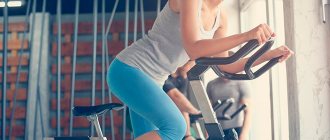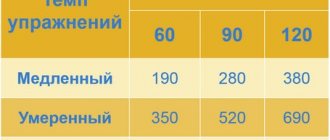- July 24, 2018
- Workouts in the gym
- Elena Spi
How many calories do you burn during a workout? This question interests not only the fair half of humanity. Burning calories means you can afford to eat more, which is especially helpful if you're trying to manage your weight. You may think that the more calories you burn during a workout, the better, but the quality of your workouts really depends on your fitness and health goals. Focusing on calorie burn as a measure of your workout's effectiveness is actually quite relative and can undermine your goals.
It all depends on the constitution of the body
What is the calorie consumption during fast walking, moderate or hard running? The truth is, it depends on how long and fast you run, and how much of an extra calorie you think you're burning. Surprised? You're not the only one who has worked on developing the perfect balance between what you eat and what you lose during exercise. Many studies show that women overestimate the number of calories they use daily, sometimes by almost 1000 times! Don't forget about the calorie calculator for weight loss - it helps balance the calculations to the optimal value.
The benefit of knowing how your body uses calories for fuel is that it can help you "fat up" and change your shape. Basics:
- What you don't use goes straight into reserves (stomach, thighs, buttocks).
- For every 3,500 calories you burn above your normal weekly intake, you'll lose about a pound. This is approximately the same amount of calories burned when squatting for 2 continuous hours.
- When you sit and read, you burn about one calorie per minute.
This number increases every time you stand, walk, or run to your phone because your body requires more energy to get the job done. If the calorie consumption when swimming in the pool is 500 kcal per session, do not forget to also take into account fees, transportation, changing clothes, etc.
So how many calories do strength training burn? What influences this?
- Duration of training;
- Training intensity;
- Age;
- Floor;
- Weight;
- What shape your body is in at the moment;
- Weight of adipose tissue in relation to muscle tissue;
- Heart rate;
- The number and duration of breaks during the training process;
- The weight you take;
- The condition of the muscles and their degree of training.
The more intense the workout, the more calories you burn. The leaner you are, the fewer calories you will lose. An intense workout burns about 400 calories per hour.
Anyone who trains all major muscle groups will get more serious results than those who work on only one muscle group. If your workout is less intense, with long rest periods between sets, you'll burn about 250 calories per hour.
Heart rate and calories burned
If your heart rate is consistently high, you will naturally be able to burn more calories. If your goal is to lose weight, then you should aim to increase your heart rate. The possible maximum during training is an increase of 75-80%. Such numbers are achieved during intense training. There are several other factors that affect the number of calories you burn, so it's difficult to say exactly how many calories you burn specifically through strength training. So remember that strength training burns an average of seven to nine calories per minute.
For example: training to burn fat.
Metabolism is the way to start your engine
Scientists measure exercise intensity in METs (metabolic equivalents):
- the more difficult the task is to complete, the higher your MET;
- For weight loss and health benefits, you should engage in at least three METs of activity per hour - this is enough to burn about 200 calories per hour;
- There should be at least a week of time to burn calories.
Below is a convenient table that you can use to guide you regarding the calories burned. If you don't know how many calories you burn doing push-ups or another activity, for example, just look at the list of exercises to create a fat loss plan.
| Training and its form | Burning calories |
| Mountain biking | 546 kcal per hour |
| Skiing | 512 kcal per hour |
| Free swimming | 479 kcal for 3 passes |
| Dumbbell Raise | 386 kcal in 15 minutes |
| Interval training | 677 kcal in 15 minutes |
| Hiking | 312 kcal for 5 km |
| Power training | 320 kcal in 5-7 minutes |
| Social dancing | 349 kcal per hour |
| Cardio training | 780 kcal for 20 minutes of continuous exercise |
| Yoga | 140 kcal in 2 hours |
| Pilates | 160 kcal in 2 hours |
We should also talk about common and well-known cardio workouts, which can be intense, variable and even strength. Nowadays, the technique of interval strength cardio exercises is beneficially used, when the movements alternate - first pushes from the floor are performed, then squats of various types to the floor. The maximum break between movements is 15 seconds, and the entire session lasts 15-20 minutes. Each exercise is done for 45 seconds, where you need to do as many approaches as possible. One approach can take up to 700 kcal, which is almost the same amount of calories spent when doing pull-ups on a horizontal bar for 7 hours.
Factors affecting calorie burning
The computer on the elliptical trainer or treadmill shows the average number of calories burned. It takes into account only the weight, height, gender and age of the athlete. But these parameters are not enough for accurate calculations. It is important to consider others, such as:
- Training intensity. The more actively you work in the gym, the less rest between approaches, the sooner you will part with the hated calories. On average, active strength training allows you to burn 400 kcal.
- Weight lifted. The more weight you lift, the more fat your body burns.
- State of muscle mass and degree of training. The greatest progress in burning fat will be noticeable among beginners. Their muscle mass grows faster and fats are burned more actively.
- Balance of fat and muscle tissue. A person with developed muscles, whose body contains less fat, will burn it more slowly.
- Training different muscles. A bodybuilder who works different muscle groups during a workout loses weight faster than someone who works only on specific muscles. In addition, if an athlete rests a lot between exercises, he will lose much less - approximately 250 kcal per workout.
- High heart rate. It has been experimentally proven that exercising at a high heart rate makes it possible to burn more fat. Sports doctors say that it should be at the level of 75-80% of the norm, i.e. within 120-155 beats/min.
Important! It is estimated that during intense training a person loses an average of 7-9 calories per minute.
Active weight loss is helped by the so-called “drying” - a type of strength training in which the athlete does light weights with a large number of repetitions. With this approach, metabolism improves, and fats are lost much more actively. In addition, drying allows you to get a sculpted figure with clearly defined muscles.
Important! Training should bring you physical and mental pleasure. And this is not just a motivating slogan. With positive emotions, the body produces catecholamines, which accelerate the burning of glycogen reserves.
How many calories are burned per hour during different workouts?
Bodybuilding classes
Such activities, depending on body weight, burn:
- up to 80 kg – 400-500 kcal;
- up to 100 kg – 600-700 kcal;
- over 100 kg – 700-800 kcal.
Jumping rope
Allows you to burn 7.3 kcal per kilogram of body weight. Thus, a person weighing 70 kg will lose 504 calories, and a person weighing 90 kg will lose 648 kcal.
Exercise bike
Here, fat burning depends not only on body weight, but also on driving speed. For example:
- at 3.5 km/h a person will spend 2.54 kcal per 1 kg of weight;
- at 10 km/h – 4.26 kcal/1 kg;
- at 15 km/h – 6 kcal/1 kg;
- at 20 km/h – 8.5 kcal/1 kg.
Elliptical trainer
For people with a lot of weight, for whom jumping and running are contraindicated, an elliptical trainer helps to lose weight. At a heart rate of 120 beats/min. The rate of fat burning here is approximately 12 kcal/1 kg of body weight, which means:
- with a weight of 60 kg – 720 calories per hour;
- with a weight of 70 kg – 840 calories per hour;
- with a weight of 80 kg – 960 calories per hour.
Important! Only professionals can maintain such a high heart rate for 1 hour. If the heart rate drops to 90-100 beats/min, the number of calories burned will drop to 6-7 kcal per hour.
Stepper trainer
This simulator is designed for practicing classical or Nordic walking at home. Thanks to training on a stepper, it is possible to remove the “breeches” and tighten the skin, forgetting about cellulite.
Practice shows that an hour-long session on a stepper allows you to say goodbye to 400-550 calories, depending on body weight and the intensity of the process.
Treadmill
The classic cardio workout is running on a treadmill. Most treadmills are equipped with computers that, when you enter your parameters, show your calorie consumption. But if there is no computer on the simulator, you can focus on the following numbers:
- active walking – 200-300 calories per hour;
- running with stops – 400-500 calories per hour;
- intense running – 600-800 calories per hour.
Zumba, aerobics and dancing
Today, dance fitness programs that combine dancing, aerobics and strength training have become popular. Like classical aerobics or dancing (sports, ballroom), they allow you to maintain a slim figure, have a toned stomach and elastic skin. And in addition to beautiful appearance, such activities strengthen the heart and blood vessels.
It is worth adding that dance programs are extremely energy-intensive. Here are the average calories burned per 1 hour of exercise:
- Zumba – 700-1000 kcal;
- ballroom dancing – 270-370 kcal;
- modern dances – 180-310 kcal;
- disco – 300-520 kcal;
- calm aerobics – 160-280 kcal;
- active aerobics – 370-630 kcal.
Water aerobics
Let's talk separately about water aerobics. This type of exercise is especially useful for people who, due to joint problems, are forced to give up running or regular gymnastics.
Water aerobics strengthens the immune system and improves the functioning of the cardiovascular system. In addition, such aerobics activates metabolic processes, promoting weight loss.
Depending on the intensity, 1 hour of such exercises allows you to get rid of 300-500 calories.
Yoga and Pilates
Yoga or Pilates classes can be an excellent addition to active fitness programs. Both of these practices improve the flexibility of the body and increase joint mobility by strengthening ligaments and improving metabolic processes in the joints.
An hour of yoga can burn up to 180 calories. Pilates is more energy-intensive. It helps you get rid of 280 calories per hour of exercise.
Now you know what activities are suitable for fighting extra pounds. This means you can organize your workouts in such a way that you can systematically lose weight and enjoy your workouts.
Health and beauty to you!
Calories are burned even while you sleep
To maintain vitality, a person also needs to expend energy reserves. Your basal metabolic rate (BMR) is breathing, blinking and thinking, and it's what you do every day. All together make up 60 to 70 percent of your total daily calories. Although your metabolism is genetically determined, it has no limits.
Your weight needs to be divided by 2.2 and multiplied by 24 = BMR. This is how metabolism is considered, but this is a relative value - a calorie calculator for weight loss is also very important to keep in order to monitor the amount of food eaten. To speed up your metabolism, you need:
- Focus on the muscles. At rest, muscle burns more calories than fat tissue. Regular strength training can increase your metabolism by 7 to 10 percent—about 100 calories per day added to your basal amount.
- Consume more carbohydrates and proteins. Eating low-calorie foods can backfire because you're more likely to lose your metabolism—revitalizing muscle mass rather than fat. Nutritionists recommend cutting your daily intake to no more than 1,000 calories from what you need to maintain your weight—about 2,000 kcal for those over 25, 2,200 to 2,500 kcal for teenagers.
- Drink coffee and caffeine-containing foods to jump-start your metabolism.
The more intensely you push yourself, the faster you can do the work required to burn calories that could previously have been burned in half a day or a day.
How to do cardio to lose weight?
Unfortunately, cardio training for weight loss may not produce visible results, even with regular exercise. For example, if you don't watch your calorie intake, you may regularly overeat after workouts, causing your weight to stay the same. It is also important to keep your heart rate in the cardio zone, otherwise fat burning will not start.
The duration of the training is also important. It has been proven that the process of fat oxidation begins from the 20th minute of running. If you do less, there will be no effect. The optimal time for cardio training for weight loss is 40-60 minutes. If you combine the track or bike with strength training, then just 20-30 minutes of aerobic activity before the machines is enough.
Increasing metabolism - turbo mode for weight loss: how many calories are burned in 1 hour of exercise?
Typically, your MET intensity increases as you:
- You tense your muscles. Your muscle tissue is your engine. The more you use, the more fuel you burn.
- Tone for weight tension. How many calories does circuit training burn if it is not varied in any way with monotonous and lengthy exercises? Activities such as running burn more calories at a higher level than those that maintain your weight, such as cycling. Trade-off: You can usually perform sedentary activities for longer to make up the difference.
- Work harder. A fast swimmer burns more calories than a slow or lazy boxer with one punch. Walking uphill will require more energy than walking through parks. And accelerating is a surefire way to go into turbo mode to burn calories. For example, burning calories during physical activity at intervals will occur quickly only at the beginning of the exercise, and then the excess weight will gradually disappear.
By following simple rules, you can adjust your diet, day, and overall figure without much effort.
Which workouts burn fat the most?
It so happened that strength training is chosen by people who want to build muscle mass. And those who want to lose weight opt for aerobic exercise - running, cycling, swimming, etc.
This is actually the wrong approach. Practice shows that lifting weights helps burn calories much more efficiently than running or cycling. Moreover, it has been scientifically proven that after strength training, fat continues to be burned for another 36 hours!
The experiments carried out confirmed another theory. To maximize fat burning, you need to combine strength training with cardio exercise. Ideally, physical activity should look like this: 3 strength training sessions per week and 2 cardio sessions. It is only important to understand how many calories certain exercises will allow you to burn. It’s also worth understanding what determines the level of calorie burning and how to increase it.
How many calories does strength training burn per hour: basic myths about sports and body tone
MYTH 1: Walking or running a kilometer will burn the same amount of calories. This is wrong. Running is a more vigorous activity because you are jumping off the ground every time. The one kilometer you run burns twice as many calories as walking the same distance.
MYTH 2: You need to focus on the problem area so that it loses weight first. Women find that low-intensity exercise burns fat from their thighs or buttocks. This is not the case. If you exercise lightly for 15 minutes and burn 100 calories, 75 percent of them may come from fat stores rather than muscle mass. If you exercise very hard for 15 minutes and burn 200 calories, only 50 percent will be lost from body fat, even though you've expended more energy. Strength training and calories go together, which is why it is so important to monitor the rhythm when performing movements.
MYTH 3: You don't believe in numbers on a treadmill. But you program your weight, and the machine calculates how many calories you burned at a certain workout intensity.
MYTH 4: You burn more calories in the cold. The truth is that you burn calories when you try to stay warm. This also requires energy. But once you're warmed up during exercise, you won't use more energy just because it's cold outside. You will end up wasting your time and energy.
MYTH 5: High-calorie-burning exercise is better. The same amount of calories spent doing squats is not lost in 4 hours of running. No, of course, if a woman gets tired after an hour of strength training, she will spend the rest of the day in a state of depression and excessive fatigue. It will be more difficult to recover, even in your sleep. It is better to focus on short exercises with greater impact.
Being active is important for any weight loss or weight maintenance program. When you are active, your body uses more energy. When you burn more calories than you consume, you lose weight.
Types of ministeppers
The difference between the mini version and the devices in sports clubs is its compact size and the absence of handrails. Their platforms are no more than 40 cm in length and 30 cm in height. Some models are equipped with hand supports or expanders. The ministepper mechanism operates on the principle of hydraulic cylinders. It begins to operate under the force of your feet pressing on the pedals, virtually silent and quite reliable. In devices with dependent travel, the left and right pedals work alternately: when one goes up, the first goes down. For models with independent lever travel, each lever operates autonomously. The second option is more preferable for rehabilitation training after injuries or operations.
Many models allow you to adjust the resistance force, maximum step length, and are equipped with electronic sensors for training pace, heart rate and other biometric parameters. In addition, they differ in functionality and set of additional options.
- Classic. The most budget option. Steppers with dependent pedal movement and hydraulic mechanism. During work, they simulate climbing stairs. The muscles of the legs, back of the thighs, and buttocks are well worked out. Does not create stress on the knee joints. Suitable for obese, elderly and people with a low level of athletic training.
- Rotary. They cost more than the classic ones. During movement, the pedals turn at a slight angle to the sides, like on skis, forcing the muscles of the inner and outer thighs, as well as the abs and spine, to actively work. Many models of this type are equipped with elastic expanders for maximum intensity of exercise throughout the body. The rotary ministepper is an excellent device for sharpening your figure and correcting problem areas.
- Balancing. The most complex mechanism that allows the pedals, in addition to moving up and down, to move forward and backward. Such exercise machines provide maximum training for all muscle groups in the legs and core, forcing you to maintain balance during exercise. Suitable for both weight loss and rehabilitation training for diseases of the musculoskeletal system.
Assessing accurate data
If you typically burn a certain number of calories during a certain type of workout, you can increase that number to burn more fat reserves or decrease it if you're feeling rundown. Most cardio machines will give you the total amount of energy burned, but keep in mind that this is just an estimate. The device does not take into account all factors that affect the intensity of physical activity, such as:
- Age: The older you are, the harder it is to work towards higher intensity levels. Do you know how many calories are spent doing push-ups? Just bend your knees and the effectiveness will drop by 45%, although the intensity will increase. There is no point in this, of course.
- Body composition: A person with more muscle often burns more calories than a person with higher body fat.
- Temperature: The warmer the environment you work in, the more calories you will burn. This raises your body temperature, so you need to remove as much energy as can be used to burn calories.
- You can also train for longer, but must be careful not to overdo it to the point of running out of heat.
- Fitness level: An experienced athlete will burn fewer calories because his body has become more efficient at training, and it will take a month to lose body fat, which is almost non-existent, while a beginner will only need a week.
- Diet: Your metabolism is the rate at which your body burns calories, so your diet directly affects you. If you don't eat enough, skip meals, or eat unhealthy foods (including too much caffeine), your metabolism can drop and affect your caloric intake.
- Sleep: Not getting enough sleep can cause you to lose less than you otherwise would. Not only will you feel more tired, but you will also exercise less.
- Oxygen consumption: It gives your body the energy it needs to continue functioning. People who breathe more during exercise tend to burn more calories. This indicates that you are working harder and for every liter of oxygen you consume, you burn 5 calories.
Your best option is to use these numbers as a base setting. They may not be entirely accurate, but at least you have an idea of which activities tend to use up more energy. For example, if you usually walk at a speed of 3 kilometers per hour, try increasing the speed to five kilometers or changing the incline of the path. Just as counting the calories in your food can help you reach your weight loss goals, you can find out how many calories you burn during a workout.
Tables
There are special sports applications for running and cycling, which, together with additional gadgets (heart rate monitor and sports watch), more or less accurately calculate the number of calories burned during training. For example, Garmin watches like the Fenix 3 and Forerunner 920XT theoretically take ambient temperature into account, while the Strava app takes into account the weight of the bike.
But for other types of activities - yoga, Pilates, step aerobics, functional training, weight lifting, and so on - it is much more difficult to get at least average data. For this purpose, special tables are compiled that will give you only a general idea of the number of calories burned. But it's better than nothing. We offer you data for the main types of training.
- Aerobics - 5.2 kcal per hour per 1 kg of weight.
- Fast dancing - 7.4 kcal per hour per 1 kg of weight.
- Football - 4.4 kcal per hour per 1 kg of weight.
- Volleyball - 4.8 kcal per hour per 1 kg of weight.
- Jumping rope - 5.6 kcal per hour per 1 kg of weight.
- Exercises on an elliptical trainer - 7.4 kcal per hour per 1 kg of weight.
- Climbing stairs / step - 7.4 kcal per hour per 1 kg of weight.
- Stretching - 1.8 kcal per hour per 1 kg of weight.
- Weight training - 3.8 kcal per hour per 1 kg of weight.
- Ashtanga yoga - 6 kcal per hour per 1 kg of weight.
- Static yoga - 3.2 kcal per hour per 1 kg of weight.
- Exercise cycle - 4.4 kcal per hour per 1 kg of weight.
- Light step aerobics - 7.4 kcal per hour per 1 kg of weight.
- Intense step aerobics - 10.6 kcal per hour per 1 kg of weight.
- Exercise bike (medium load) - 7.4 kcal per hour per 1 kg of weight.
- Exercise bike (intensive exercise) - 11.1 kcal per hour per 1 kg of weight.
- Rowing machine - 7.4 kcal per hour per 1 kg of weight.
- Intensive weight lifting - 6 kcal per hour per 1 kg of weight.
Calculator for calculating calories burned during strength training.
Swimming is a different story, since the clock does not take into account the number of calories that the body spends on heating, because the water temperature is always lower than body temperature.
Typically, swimmers expend four times more energy than track and field athletes. Swimming at a speed of 400 m/h burns 3 kcal per 1 kg of your body weight per hour, slow breaststroke - 6 kcal, slow crawl - 7 kcal, fast crawl - 8 kcal.
You can calculate the approximate number of calories burned during your swimming workout manually and compare it with the indicators that the application will give you based on the data received from your watch.
System for reducing caloric content of foods
To lose weight, most people need to reduce the number of calories they consume and increase their physical activity according to diet recipes. In general, this means that in order to lose 0.7 kilograms per week, you need to reduce your daily calories by 500-750 units.
Diet or exercise: which matters more? Both factors are important. Diet has a stronger effect on weight loss than physical activity. The latter, including exercise, has a stronger effect on preventing weight regain after weight loss. To restore the strength spent on exercise, you need to understand how many calories are spent when pumping the abs or another part of the body in 1 minute. This will allow you to correctly schedule your training plan.
What's the benefit?
Without a doubt, circuit training is beneficial for girls and men. Main advantages:
- Save time. The rest here is supposed to be short, which means you can do much more than during regular training.
- “Pumping” of the respiratory tract and heart. This is ensured by the fact that the rest is short, or even absent. At the same time, during exercise there is an active consumption of oxygen, which has a positive effect on all organs and systems.
- Losing weight. During training, a person's pulse accelerates, and this helps reduce the amount of fat and increases muscle mass.
Group classes
Aerobic programs
Functional training
Diet or sports: what is more important and what can be avoided?
Losing weight through diet without physical activity, especially in older adults, can increase frailty due to age-related losses in bone density and muscle mass. Adding aerobic exercise can help with weight loss. Doctors recommend including the following features for scheduled classes:
- Aerobic activity. Spend at least 150 minutes a week doing moderate activity or 75 minutes a week doing vigorous activity. However, to effectively lose or maintain weight, some people may need up to 300 minutes per week of moderate exercise. You can combine moderate and vigorous activity, alternating or replacing some training disciplines.
- Power training. Do strength training at least twice a week.
- Moderate aerobic exercise includes activities such as brisk walking, swimming and ballroom dancing. Vigorous activities include running and dance exercises. Strength training may include the use of kettlebells and barbells.
These activities will help you stay in shape, even if your diet needs to be adjusted or completely canceled. Even to maintain weight, when you no longer need to lose weight, sports are very important for the body, because we don’t know how many calories are burned on exercise equipment, which no longer brings as much benefit as before. Having known this, you can predict in advance weight gain from incorrectly selected foods.
The effectiveness of cardio for weight loss
The essence of aerobic exercise is to trigger instant fat burning due to the oxidation of oxygen. While running, cycling or working on an orbital track, you can burn from 400 to 600 kcal in 1 hour. If you exercise regularly and do not overeat after training, you can lose up to 5 kg in a month.
A significant advantage of cardio is the benefits for the heart. By training your heart muscle, you improve the health of your entire body and also increase your endurance.
In addition, running and cardio exercises tone the muscles of the legs, buttocks and abs, modeling the figure.
Beginners are recommended to start training in the gym with cardio training for weight loss and general strengthening of the body. If you are overweight, walking on a treadmill is especially useful, and in all other cases - an orbiter, an exercise bike, a rowing machine, or even a treadmill. Cardio equipment can be alternated with each other to comprehensively develop muscles.
In order for cardio training for weight loss for beginners to bring maximum effect, it is recommended to exercise under the supervision of a trainer and nutritionist. At the Multisport club you can get advice from a nutritionist who will develop a diet menu taking into account the individual characteristics of the body.
Simple tips for burning fat
Surely your friends play sports or just enjoy walking in the evenings. Try doing a few exercises, the tricks of which will help you maintain muscle tone and figure.
- Avoid nuts—they have healthy fats but are also high in calories: 1 handful (about one cup) of the buttery, toasted goodies has 175 calories. Can't resist? Eat pistachios: 2 handfuls contain only 159 calories.
- Additions to salads. A big vegetable dish may seem healthy, but all those goodies on top can make it richer and more calorie-dense than lasagna or fettuccine Alfredo. Cheese crumbles, caramelized nuts, bacon, avocado, dried fruit, croutons and vinaigrettes can also add a few pounds of extra weight. It’s not so important how many calories are spent during a workout, it’s important not to return them “to their previous places of residence.”
- Use small plates. You will consume 40% less food, which will affect your figure.
- Small snacks. Any crackers or savory snacks can contain up to 900 kcal per package. The less you consume, the more energy you save for digestion. And famine will come much later.
- Eat less pasta. One serving contains only 220 calories. But typical restaurant meals can be 480% fattier than 1 plate of durum prepared at home.
- Try to eat alone. Feasts with friends allow you to eat three times more than you can consume on your own.
- Don't finish your food. Leave 25% of your food on your plate at every meal.
- For breakfast, eat 2 boiled eggs to satisfy your hunger.
- Before lunch and dinner, enjoy 1 cup of low-calorie soup or water to fill your stomach.
- Don't eat in front of the TV. You simply don’t notice that you are eating more than you need to meet your needs.
Don't forget to indulge yourself with sweets, but only before 12 noon. Take fasting days when you don’t work, walk and breathe air. Sometimes you can drink alcohol to improve blood circulation. And remember, how many calories are spent during training, the same amount is burned during sleep after the end of the working day. Be sure to get enough sleep, this will improve your overall condition and help you lose weight.
Full standing cardio workout
Fat-burning cardio workout for home includes 5 rounds of 5 exercises in each round. All exercises are performed standing; you do not need a mat. Don't forget to start your workout with a warm-up and end with stretching. We strongly recommend training in sneakers.
Before starting your workout, download the Tabata Timer app to your mobile phone, which will help you set work and rest intervals.
Workout for 15-20 minutes:
- Easy level. Perform exercises according to the scheme: 15 seconds work, 15 seconds rest. Rest 1-2 minutes between rounds. Ready timer 15/15.
- Advanced level. Perform exercises according to the following scheme: 20 seconds work, 10 seconds rest. Rest 1-2 minutes between rounds. Ready timer 20/10.
Workout for 30-35 minutes:
- Easy level. Perform exercises according to the following scheme: 30 seconds work, 30 seconds rest. Rest 1-2 minutes between rounds. Ready timer 30/30.
- Advanced level. Perform exercises according to the following scheme: 40 seconds work, 20 seconds rest. Rest 1-2 minutes between rounds. Ready timer 40/20.
Workout for 40-50 minutes:
- Easy level. Perform exercises according to the following scheme: 20 seconds work, 20 seconds rest. Repeat each round in 2 circles. Rest 1-2 minutes between rounds. Ready timer 20/20.
- Advanced level. Perform exercises according to the following scheme: 30 seconds work, 15 seconds rest. Repeat each round in 2 circles. Rest 1-2 minutes between rounds. Ready timer 30/15.
We recommend doing an easy level workout for the first time to evaluate your physical capabilities. In the future, you can move on to the advanced lesson plan. When resting between rounds, walk in place and do not sit or lie down.
Fat Burning Cardio Workout (Round 1)
1. Jumping with arms raised
Jumping is carried out by pushing off the floor with your toes. When jumping, you need to spread your legs wider than your shoulders, additionally straightening your arms in different directions until they are approximately parallel to the floor. Hold the star position for a split second, then return to the starting position. An element of cardio training for every day tones the body, stimulates the cardiovascular system, and also puts a comprehensive load on the muscles of the legs, arms and shoulders.
2. Squats with arm raises
We work from a standing position with our arms raised up. While inhaling, we squat to a right angle in the bend of the knee joints. At the same time, we lower our upper limbs and move them slightly back. After a short delay while exhaling, we rise back with effort, raising our arms up. We perform the whole approach using a similar amplitude. The exercise helps strengthen the leg muscles, works the deltoid muscles, and engages the abdominal and core muscles.
3. Half lunges
with kick (right leg)
4.
Half-lunges with a kick (left leg)
We work from a standing position with our hands fixed on the belt. We take our left leg back, simultaneously touching the floor with our left hand. After returning to the starting position, we again put our hands on the belt and kick our right foot forward. Next, we return the leg back and proceed to perform the next repetition on the same side. Please note that opposite legs are working (the left leg is pulled back, and the kick is made with the right leg). After completing the approach, change sides. The element of cardio training for weight loss perfectly develops the overall endurance of the athlete, with an emphasis on strengthening the muscles of the lower extremities.
5. Knee raises with body rotation
We spread our legs at shoulder level and raise our arms, fixing one palm on the other. Now we lift the right knee while simultaneously rotating the body. At the peak point, the knee should connect with the elbow of the left hand, as the arms must be lowered forward until they are parallel to the floor. The palms remain closed. The element places an accentuated load on the oblique muscles, lower abs, and quadriceps. Despite its apparent ease, the exercise quickly increases your heart rate and accelerates fat burning.
Fat Burning Cardio Workout (Round Two)
1. Running in place with punches in front of you
We begin to run in place, trying to raise our knees higher. For each step we make strikes in front of ourselves. In the process of lifting the right knee, the left hand hits (and vice versa). Inhale for 2 steps, and exhale for another 2 steps. This method of breathing will help avoid tingling in the side, which is especially important for beginner athletes. Running in place is, in principle, an integral part of a fat-burning cardio workout at home. It puts stress on the entire body – legs, arms, abs.
2. Squat + kick
We place our feet shoulder-width apart and turn our toes slightly in different directions. When performing a squat, keep your arms in front of you and lower your body weight until the bend angle at the knee joint is straight. After pausing briefly at the peak point, rise with effort and kick with your left leg, raising the limb until it is parallel to the floor. For the next repetition, kick with your left foot. The exercise develops the muscles of the legs and buttocks, quickly raises the pulse due to complex movement, and focuses on the quadriceps due to additional kicks.
3. Jumping with legs moving to the sides
The specificity of the exercise is to perform alternate jumps, which are performed by pushing off one foot from the floor. The second leg is moved slightly to the side. Repulsion occurs due to the force of the foot - in other words, we bounce on our toes. In this case, your hands must be kept fixed on your belt. Inhale for 2 jumps, and exhale for another 2 jumps. A simple element of our cardio training effectively accelerates metabolic processes in the body, and also eliminates problem areas in the waist area and outer thigh.
4. Bringing the knee to the palms (right leg)
5. Bringing the knee to the palms (left leg)
We shift our body weight to our left leg and move our right leg to the side. This results in a kind of side half-lunge position. Raise your arms above your head and place one palm on the other. Next, we begin to lift the right knee to the level of the solar plexus, while simultaneously lowering our hands onto it. For the next approach we change sides. An element of cardio training for every day provides an accented workout of the lower abs and oblique muscles, and burns belly fat.
Fat Burning Cardio Workout (Round Three)
1. Jumping with shin overlapping and arm swings
We spread our legs slightly wider than our shoulders and raise our arms above our heads. We make a jump, simultaneously performing an overlap of the right shin. Try to reach your buttock with your heel. At the same time, we lower our arms to the sides, trying to touch the right foot with our right hand. We return the leg back and raise our arms to the starting position. For the next repetition, we work with the left shin, making a similar movement with the upper limbs. The cardio workout element for weight loss not only speeds up the fat burning process, but also works the thighs, calves, arm muscles and deltoids.
2. Cross leg swings with arms outstretched
We place our feet shoulder-width apart and spread our arms in opposite directions. We swing forward with our left leg, while simultaneously turning our body to the left. At the peak point, the toe of the left foot should touch the fingers of the right hand. For the next repetition, the sides change, we work with the right foot. An element of fat-burning cardio training at home provides high-quality work on the oblique muscles, strengthens the lateral parts of the body, and also loads the quadriceps.
3. Quick steps to the side in a half squat
Bend your knees slightly, supporting your body weight in a half-squat. Next, we take a wide step to the right side and substitute our left foot. Now we change sides and step to the left, exposing our right foot. We work at an intense pace, inhaling at the moment of performing the starting movement and exhaling at the moment of performing the extension step. The exercise combines static and dynamic load on the lower extremities, helping not only to lose weight, but also to qualitatively tighten the thigh muscles. Additionally, the abdominal muscles work, and the fat layer in the waist area is burned.
4. Reverse lunges with knee lift (right leg)
5. Reverse lunges with knee lift (left leg)
Place your feet shoulder-width apart and clasp your hands in front of you at chest level. We take a step back with our left foot, after which we lower our body weight until the knee is a couple of centimeters from the floor. After a short pause, we return to the starting position and lift the left knee to chest level. Having completed the whole approach, we begin to work with the other leg. Lunges are one of the best exercises for developing leg strength, and knee raises strengthen your lower abs.
Fat Burning Cardio Workout (Round Four)
1. Scissors with hands and feet
The specificity of the element of fat-burning cardio training at home is to simultaneously perform steps with your toes forward, as well as cross movements of your arms in front of you. To better understand the technique, imagine moving your upper limbs like scissors. Fix each step with a tight emphasis on the toe. The fat-burning effect of the exercise is due to the simultaneous intensive work of the arms and legs, the emphasis of which falls on the back of the thigh, buttocks, arm and shoulder muscles, and pectoral muscles.
2. Squat + side steps
The legs are close to each other. When performing a squat, extend your arms down to touch the floor with your fingers at the peak point. After this, rise and simultaneously step to the left side, spreading your arms up to your sides. Next, we put our leg back again, do a squat and move to the right side. In addition to the beneficial effects on the muscles of the legs and arms, with the help of the presented element of cardio training for every day, you can lose weight and speed up your metabolism.
3. Running with shin overlapping and arm lifting
Begin running intensely in place with your shin overlapping. Add alternating arm raises to the basic movement. In the process of running, the right hand rises up to overlap the left leg, then vice versa. We inhale for 2 steps, and exhale for another 2 steps. The cardio workout element for weight loss involves working the entire body, with an emphasis on the hamstrings and deltoid muscles.
4. Pulling the knee with a step back (right leg)
5. Knee pull-up with a step back (left leg)
Bring your hands together at the back of your head and turn your elbows in opposite directions. Take a step back with your left foot, then bring it back while lifting your knee to the level of your lower chest. We work at an intense pace. Having completed the required number of repetitions, we change sides and begin working with the left leg. Again, an exercise from cardio training for weight loss focuses on the lower abs, removes fat on the abdomen and works the quadriceps.
Fat Burning Cardio Workout (Round 5)
1. Jumping with a step and bringing your arms in front of you
We take jumping steps at a distance of half a meter. At the same time, we bring our arms together in front of us, keeping them strictly parallel to the floor throughout the entire range of movement. We work according to the following system: one step we do the reduction, and the other – the extension of the arms to the sides. Thanks to the presented exercise, you can not only lose weight, but also work out the muscles of your legs, pectoral muscles, and shoulder muscles.
2. Squat + knee-elbow
We bring our hands together at the back of our heads with our elbows turned in opposite directions. Place your feet slightly wider than your shoulders, and then do a squat using the technique already familiar to us. We rise with effort, after which we raise our left knee to chest level and rotate the body, simultaneously touching the surface of the knee with our right elbow. After the next squat, change sides. An effective element of fat-burning cardio training at home, it works the abs and obliques, and also strengthens the muscles of the legs and buttocks. By engaging all muscle groups, you will burn more calories and improve the quality of the training load.
3. Fast running in place
The specificity of the presented exercise is to perform intense mincing steps. We inhale for 2 steps, and exhale for another 2 steps. Carefully monitor your pulse and your own well-being, do not speed up excessively. This variation of the classic running in place allows you to effectively work out your leg muscles, burn calories and strengthen your cardiovascular system.
4. Taking the leg to the side in a half-squat (right leg)
5. Taking the leg to the side in a half squat (left leg)
We lower ourselves into a half-squat, bending our knees slightly. We lean the body a little forward, but do not slouch, maintaining a natural deflection with straightened shoulders. We transfer the body weight to the left leg, and begin to move the right one to the side, subsequently bringing it back. Inhale for one repetition, and exhale for the next. Each approach is accompanied by a change of legs. An element of fat-burning cardio training at home helps to work out the relief of the lower extremities with an emphasis on the abductor muscles. Feel how the supporting leg works statically.
Interesting ways to avoid dieting
Remember a few rules that will help you trick your body and make it lose weight a few days after you start training.
- Turn your walk into a workout using your own calories by bending your elbows 90 degrees and pumping up your arms as you walk. Not only does this automatically speed up your pace, but it also helps you burn up to 15% more energy.
- Favorite music. You can fight calories with your favorite songs: developing your favorite playlist will help you stay on the move 20% longer and burn more calories. Music blocks fatigue, induces a feeling of alertness and helps you keep up by synchronizing your movements.
- Weights. To really target the fat layers, you need to slightly increase the load. A small weighting agent will help you in this matter. Those who used heavy dumbbells burned 25% more calories.
- Cold water in hand! To avoid feeling too tired to the point of exhaustion, control your body temperature using a simple method - hold a bottle of cool water in your hands. This will help you last longer on long walks.
- Alternate the pace - do not let your body get used to monotony. Watch your heartbeat. You must constantly enrich your cells with oxygen, and when shortness of breath appears, go for a calm walk. After resting, speed up. This is an alternative to strength training and cardio exercises with variable intensity.
Never try to replace walking or outdoor exercise with treadmills and exercise machines in gyms. Do you know how many calories are spent jumping rope in the yard? Almost one and a half times more than indoors. Oxygen and proper breathing also play a big role in this matter. If this is not possible, open the windows or ventilate and cool the room where your class will take place in advance. Heat and stuffiness are not the best companions in the fight for health and physical activity, and the heart does not need such a load.
Benefit
There are two main functions that fat burning training performs. First, suspend the formation of reserves for a rainy day. Secondly, start the process of splitting adipocytes. If it is properly organized, it works out them perfectly and ultimately leads to the figure of your dreams - without deposits in problem areas and while maintaining sculpted muscles. How does she do this?
Calorie consumption
Losing weight without a calorie deficit is impossible. Many people make a total mistake: they go on diets and hunger strikes in the literal sense of the word. That is, they reduce portion sizes, eat low-calorie foods, but at the same time continue to lead a sedentary lifestyle: they do not get out of the car or get off the couch. Losing several kilograms occurs solely due to the removal of excess fluid from the body. And then the muscles will begin to break down. To start fat-burning processes and accelerate weight loss, you need to play sports, and with a competent combination of cardio and strength training. They allow you to significantly increase your calorie expenditure while still eating quite normally.
Production of necessary hormones
Certain hormones promote the breakdown of adipocytes. However, the amount produced by the body is not enough for fat burning. You can, of course, solve this problem by taking hormonal medications, but they have too many side effects and contraindications. There is a much simpler and safer way - to organize sports activities correctly. A high level of testosterone and somatotropin, which blocks muscle catabolism and promotes the active breakdown of adipocytes, is ensured.
Acceleration of metabolism
One of the biggest problems with losing weight through diets is slow metabolism, which prevents fat-burning processes from starting. Exercising does an excellent job of coping with this difficulty, accelerating your metabolism to the desired speed.
Shaping the figure
The consequence of almost all diets without the support of fat-burning training is a decrease in muscle tone. The skin becomes flabby and sags. The muscles quickly begin to deflate and decrease in size. After all, the body draws the missing energy from it. But problem areas remain untouched.
If fat burning workouts provide such invaluable help in losing weight and maintaining muscle mass to form a beautiful figure, why is not everyone in a hurry to use them? Firstly, they need to be organized correctly (know the combination of strength and cardio loads, follow the scheme, stick to the program, etc.). If you make a mistake at such moments, there will be no result. Secondly, they are quite exhausting. Having tried it once and twice, people simply cannot bring themselves to get up from the couch and go to the training for the fourth time.










